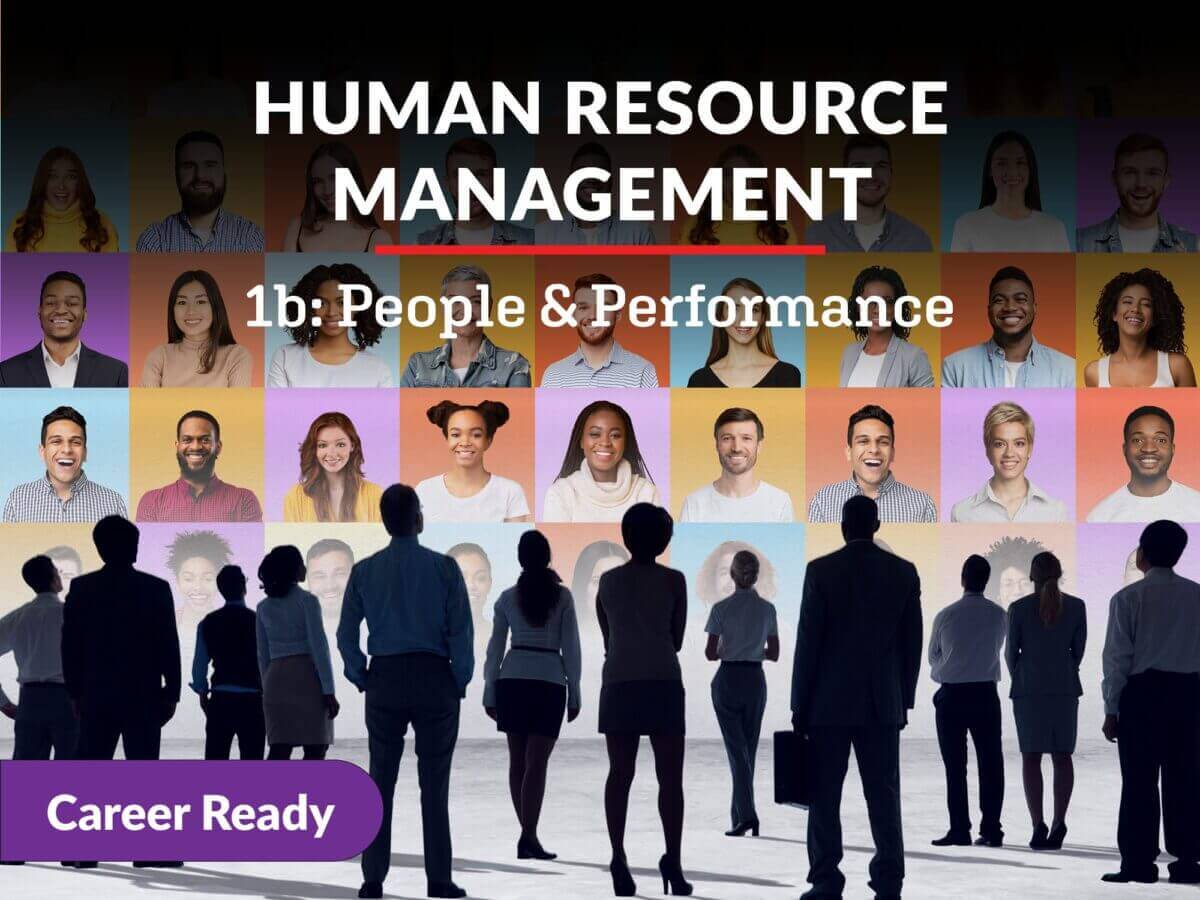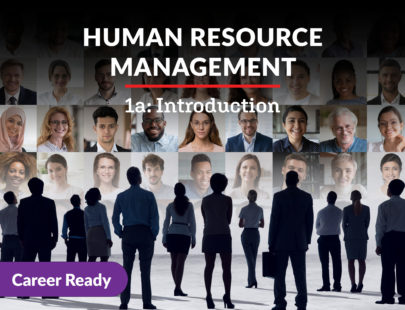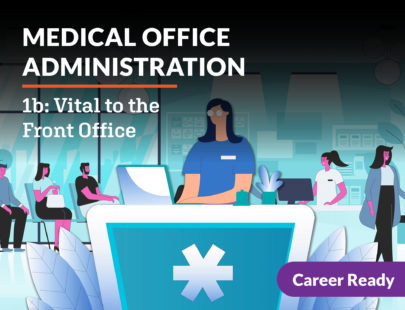
Human Resource Management 1b: People & Performance
You’ve learned the basics about the critical role HRM plays in business’ success, and now it’s time to dive deeper into the role’s main responsibilities from a practical perspective. In this course, you’ll step into the shoes of an HRM professional and explore key duties such as onboarding, training and development, retaining and terminating employees, safety and risk managements, company communication, and more! You’ll also learn about different career opportunities in the field of HRM, develop collateral based on real-world scenarios involving HRM tasks and responsibilities, and the role of HRM in a global environment. Let’s get started!
Units at a Glance
Unit 1: Onboarding and Ongoing Communication
If human resources departments are like an engine that drives the business, then communication with employees is the fuel. Nothing gets accomplished in the field of HR without conversations and sharing information among the entire team of workers. This critical exchange of information and ideas begins with the onboarding of each newly hired employee. Here we will examine the onboarding process and different strategies HR teams use for ongoing communication with their teams.
What will you learn in this unit?
- Identify the different phases of onboarding and the significance of each
- Develop an orientation program for newly hired employees
- Discuss different techniques for effective communication in the workplace
- Create a presentation to share with a team of employees
Unit 2: Training and Development
A wise philosopher once said, “The whole is greater than the sum of its parts.” This concept is an excellent way to understand what teams of employees mean to the companies where they work. HR managers understand that each employee brings a specific value to the company and that together, all of the employees help the business deliver something even greater to its customers. This underscores the importance of training and developing each player within the team.
What will you learn in this unit?
- Distinguish between employee training, professional development, and organizational development
- Conduct a four-step needs assessment in order to determine the most effective training options
- Practice several methods for delivering employee training
- Understand the various considerations involved in developing a training program
- Explain the purpose and methods of assessing the effectiveness of a training program
- Summarize different options for professional development
Unit 3: Retaining and Terminating Employees
Picture an HR manager at work and what do you see? Most likely it is an image involving hiring and firing of workers. It’s true that termination of employees is one of the essential functions of an HR professional. In some cases, HR will work to retain the employee on staff, even if that involves corrective discipline. At other times, the company may have its own reasons for reducing the size of the workforce. HRM will administer each of these processes when it is appropriate.
What will you learn in this unit?
- Describe different reasons for employee turnover
- Explain several different retention strategies
- Summarize progressive discipline for employees
- Discuss the rights and responsibilities of a terminated employee and the employer when an employee must be terminated
- Review different strategies for reducing or restructuring the workforce
Unit 4: Employee-Management Relations
At first glance it might seem as though employers have the upper hand in employer-employee relationships. After all, workers come to them needing a paycheck in order to provide for their own basic needs. But workers during the Industrial Revolution understood that employers need their workers just as much. Without workers, the employers couldn’t produce goods and services to make money. This gave birth to the concept of labor unions that work to find the balance of power in employer-employee relationships so that both parties can prosper.
What will you learn in this unit?
- Explain the difference between a craft union and an industrial union
- Identify the major federal laws regulating employers and labor unions
- Describe the challenges facing modern labor unions
- Distinguish between mandatory and permissive topics in a collective bargaining agreement
- Understand the difference between a union grievance and a complaint to the National Labor Relations Board
Unit 5: Safety and Risk Management
Slips and falls. Carpal tunnel syndrome. Asbestosis. Workplace fires. Floods. What do these things have in common? They are typical examples of workplace injuries, illnesses, and dangers that might be avoided or mitigated with the proper safety management procedures. HRM professionals are responsible for all aspects of dealing with a company’s workers, which includes taking care of their physical safety and well-being, responding to workplace safety incidents, and preparing for emergencies. Every employer must take measures to create a safe workplace and reduce all types of risk whenever possible.
What will you learn in this unit?
- Explain the federal laws about workplace health, safety, and privacy
- Describe three types of enterprise risk and strategies and how to respond to them
- Identify the steps the HRM team should take after a workplace safety incident
- Understand the variety of considerations that shape every emergency response plan
Unit 6: Data Management and Security
In a world where billions of people access the internet each day, protecting private information is more important than ever. This is true for businesses as well as individuals. HR professionals are one of the leading resources every company has to create a working environment where data is kept secure and safe from prying eyes. Let’s learn about data management and security from an HRM perspective.
What will you learn in this unit?
- Distinguish between an internal and external privacy policy
- Use visual aids to make presentations with data
- Create a records management system to assist with retention and disposal of employee records
- Explain how HRM professionals use biometrics
- Develop a policy about theft and destruction of property by employees
Unit 7: Careers in Human Resource Management
Choosing a career can sometimes feel like picking one bucket of water out of an ocean of opportunities. There are thousands of options and it can feel impossible to decide which one is best. Human resource management is a broad industry that contains “buckets” of all sizes. Some of them include more education than others, some are more focused on the law, but all of them center on creating a connection between an employer and their team of people. Which bucket is the right one for you?
What will you learn in this unit?
- Explain the difference between an HR generalist and an HR specialist
- Determine the education requirements for the different levels of HR professionals
- Identify key skills needed for anyone working in the HR industry
- Conduct a self-assessment and use the information to develop a career pathway
- Create a career ladder or lattice to map out a career plan
- Discover various ways to pursue career development, even as a student
Unit 8: Going Global: International Human Resource Management
The global workplace puts an additional emphasis on the role of HR professionals. Not only do they need to understand how to operate in one location or one country, but international businesses need HR teams that understand how to navigate important issues in a variety of countries. For example, how does HR set the salary range for workers in a separate country? Are there different labor laws that affect how the company can do business? There is an additional layer of knowledge required by HR workers operating in this global environment.
What will you learn in this unit?
- Describe strategies and business practices used by successful international employers
- Discuss the impact of the International Labor Organization
- Address compensation issues in a global environment
- Explain the benefits of outsourcing labor
Required Materials
Software
- Presentation software
- Spreadsheet software
- Word processing software
Other
- HRM professional in a leadership role
Optional
- Art supplies
- Audio recording device
- Digital camera
- Graphic design software
- Poster board
- Video recording device




